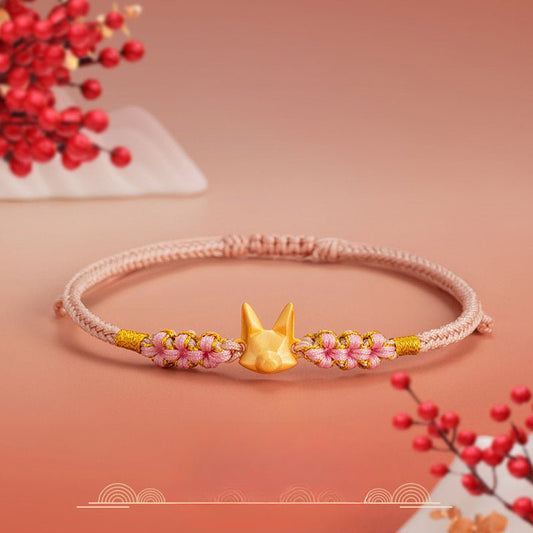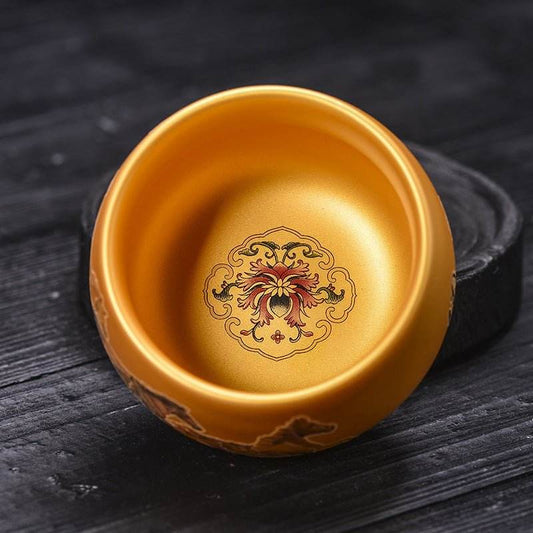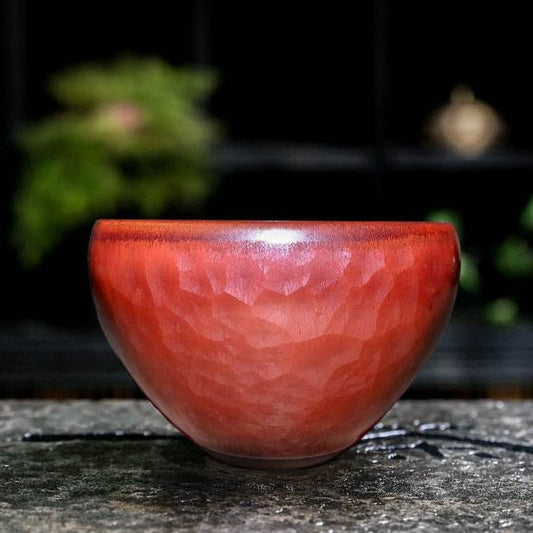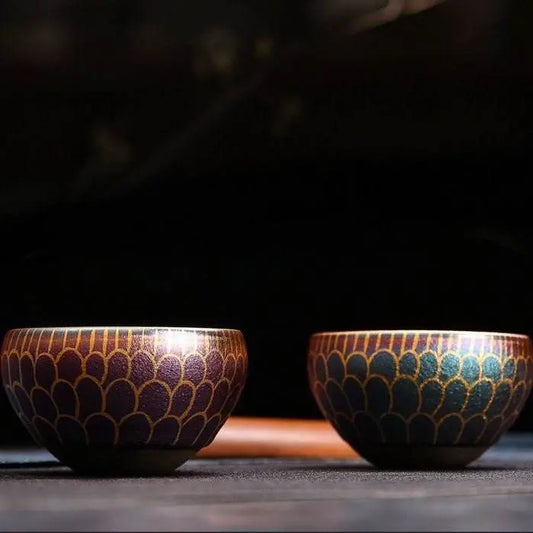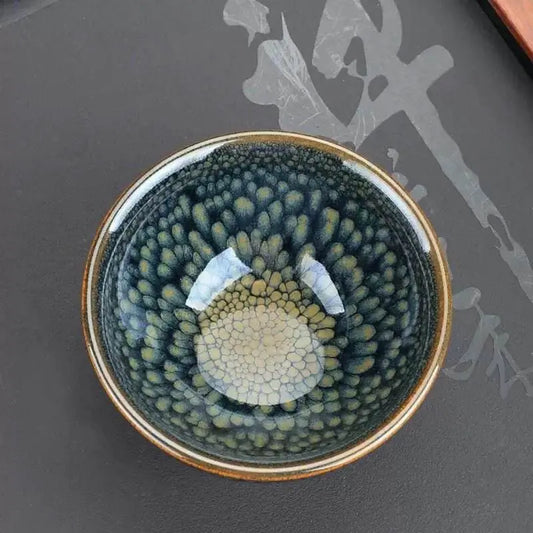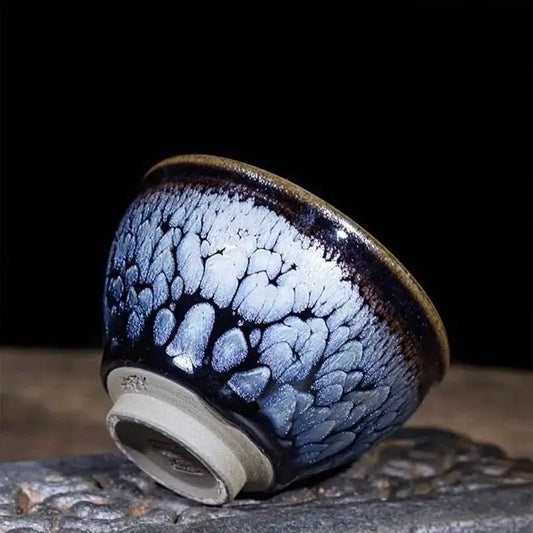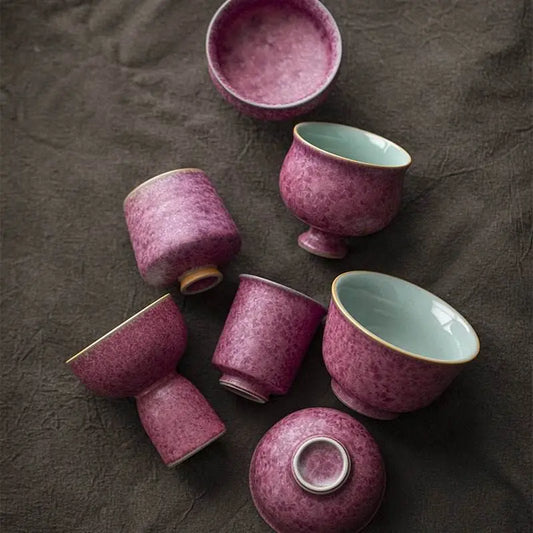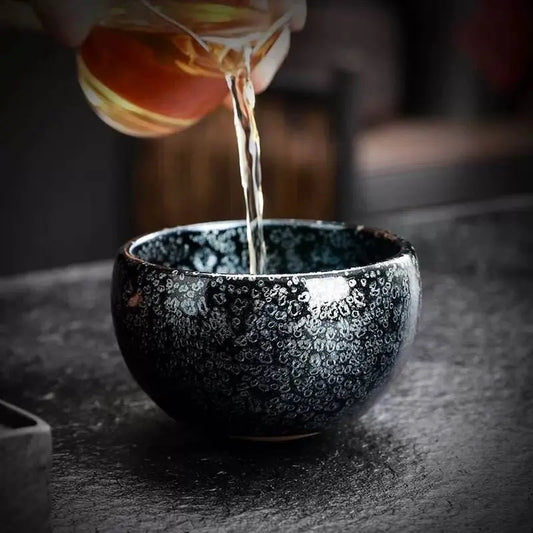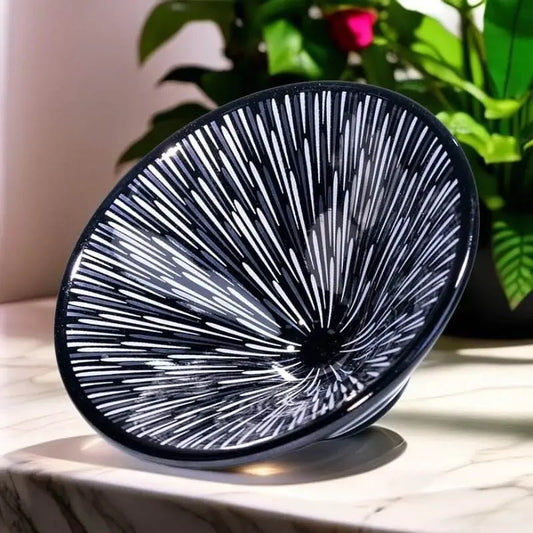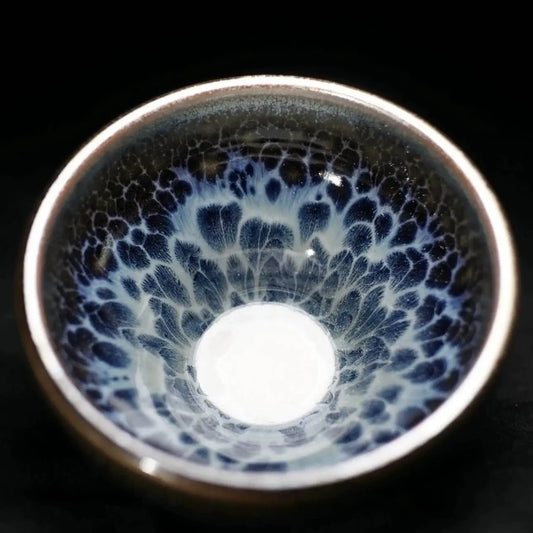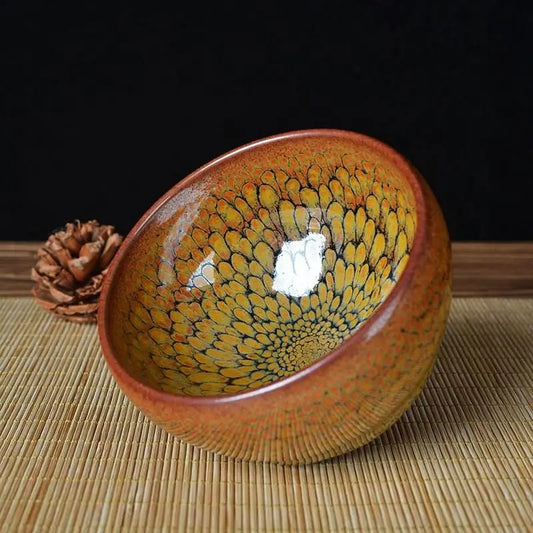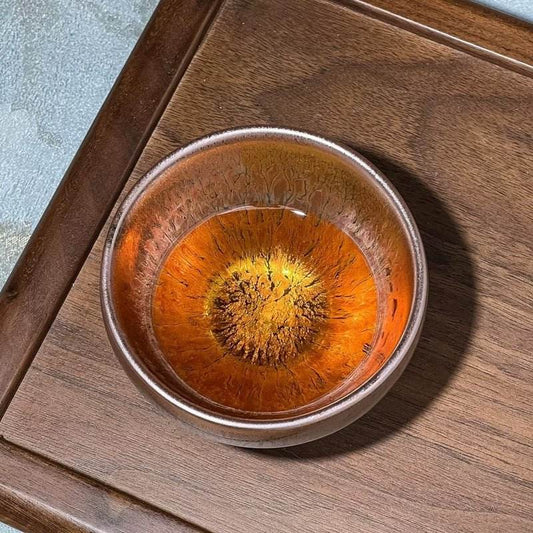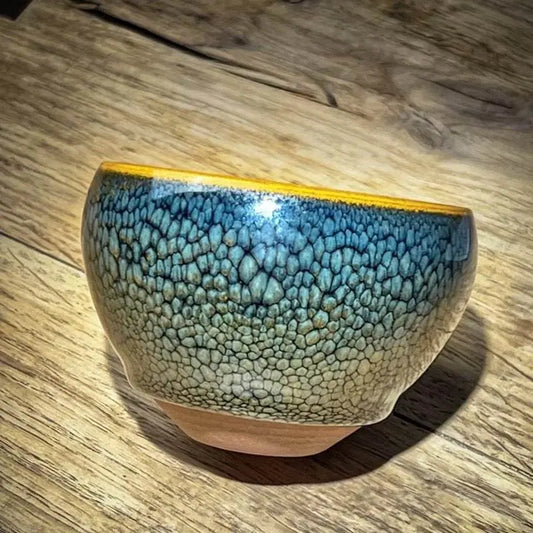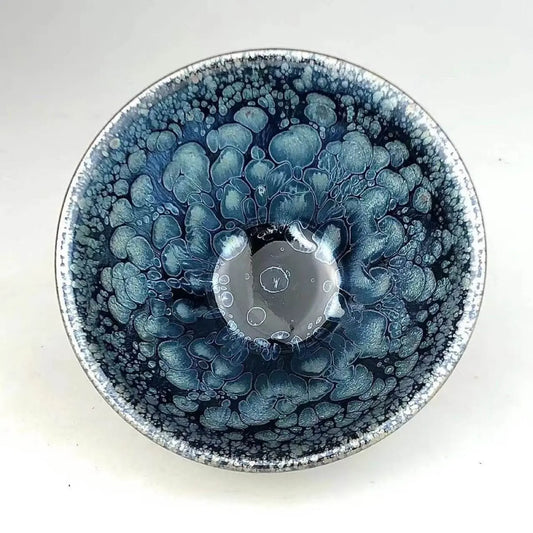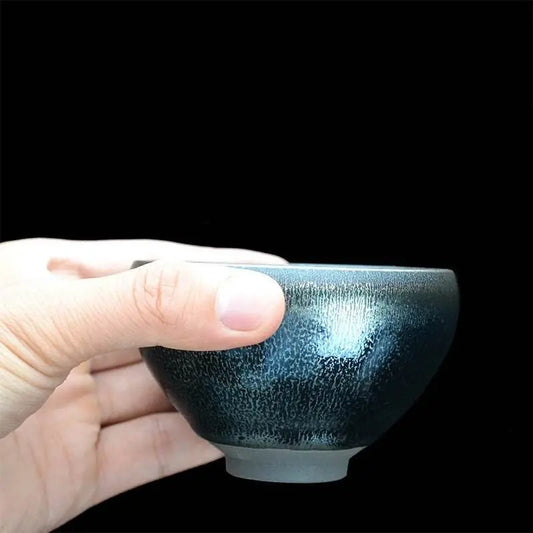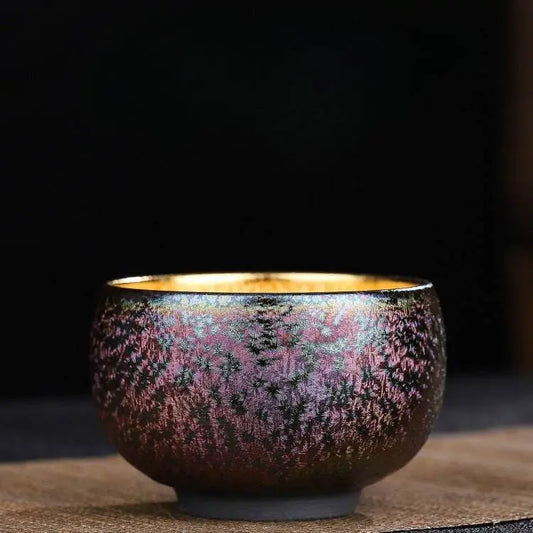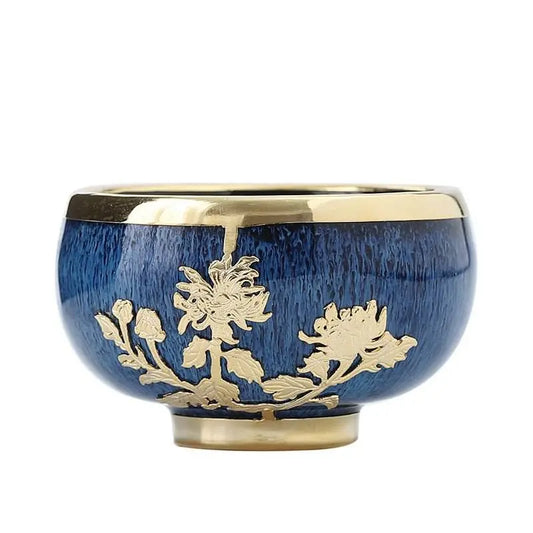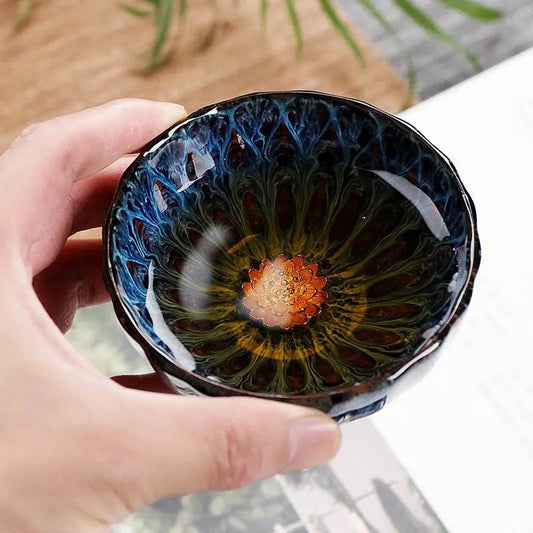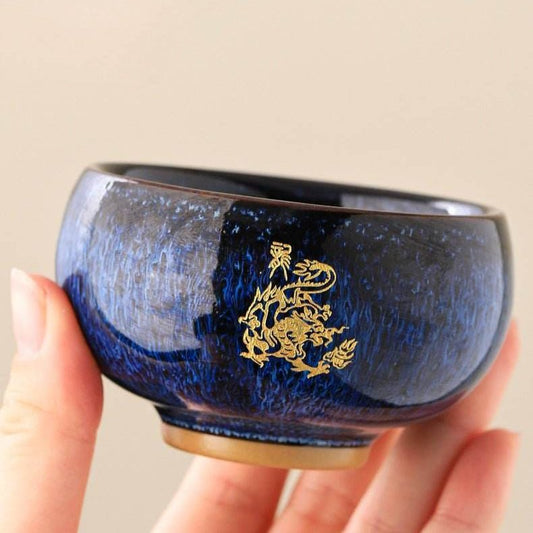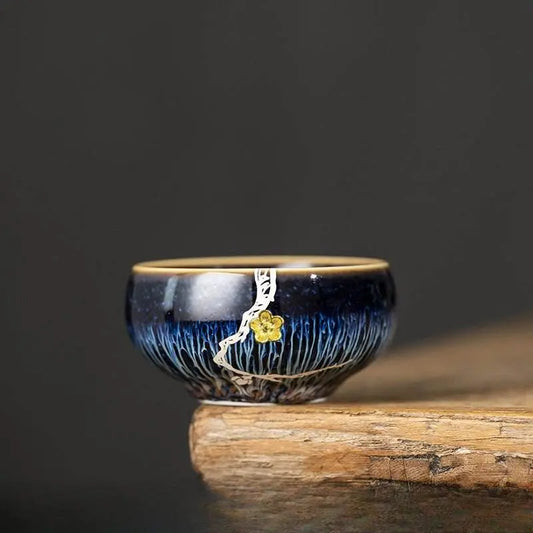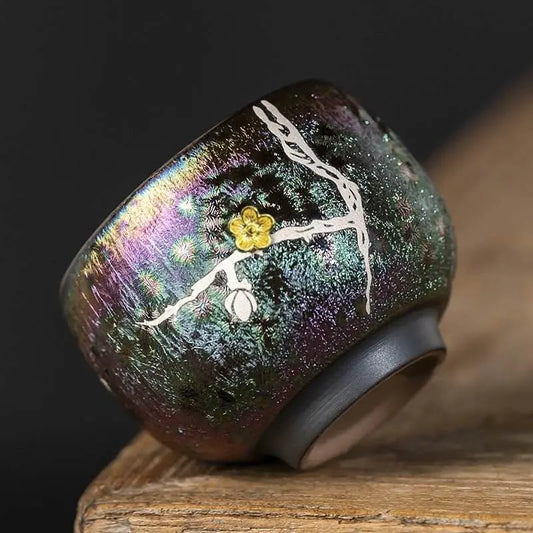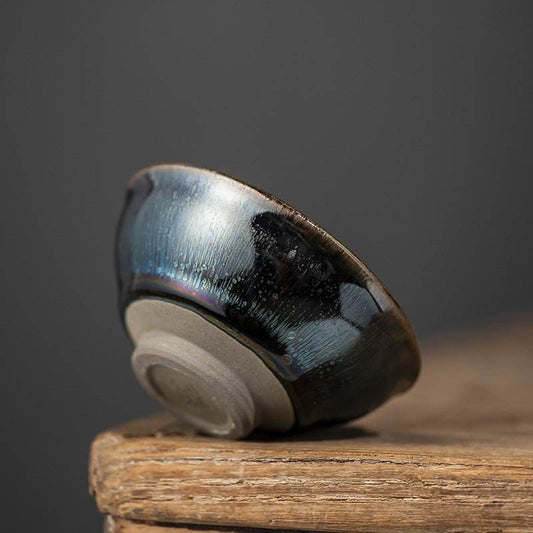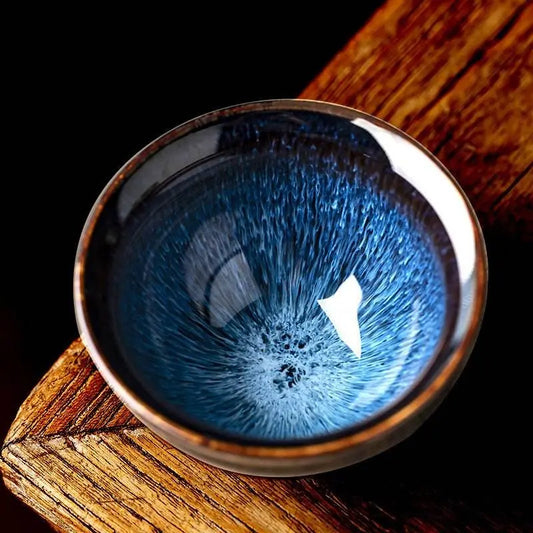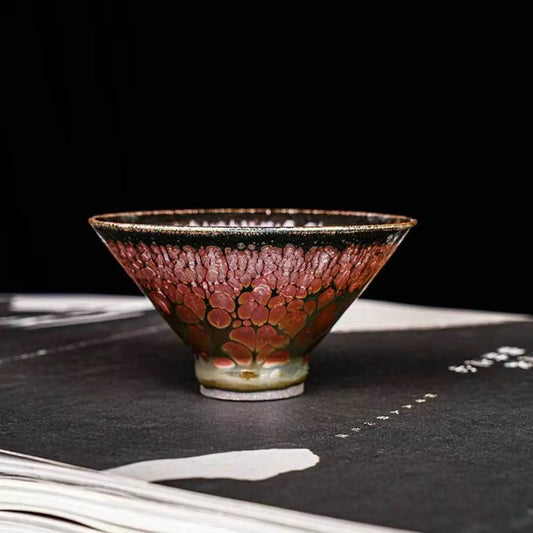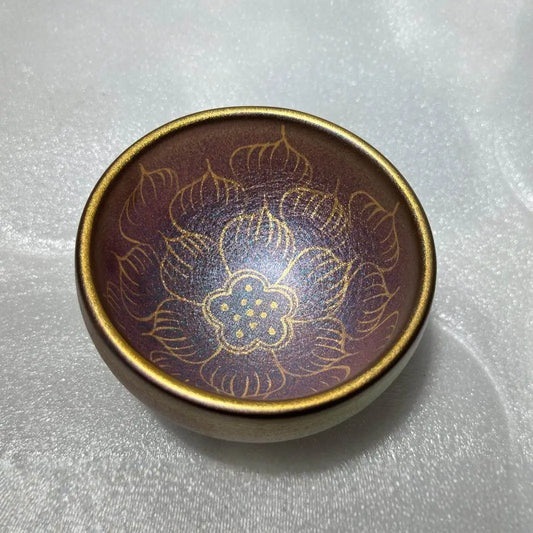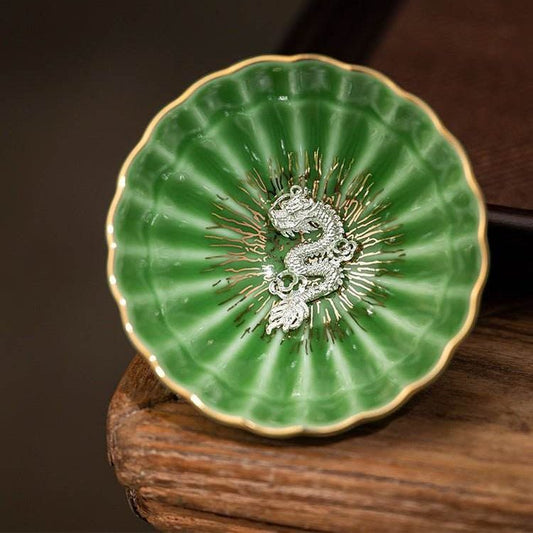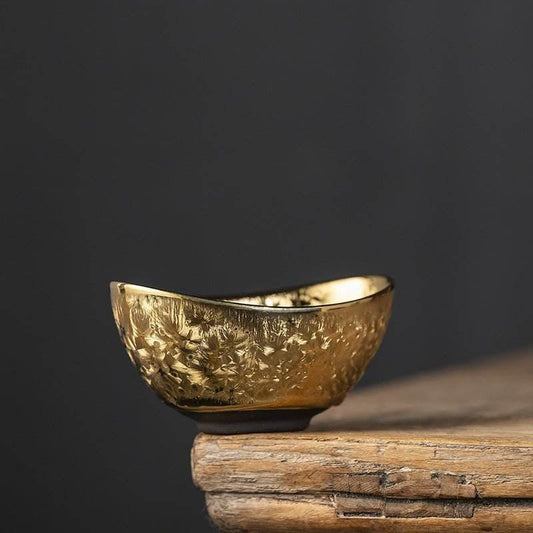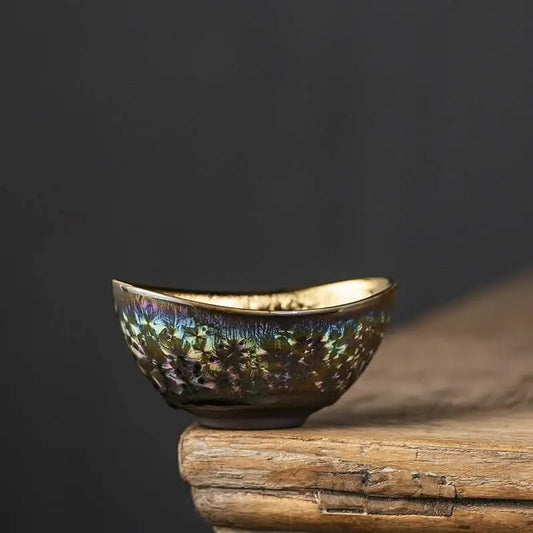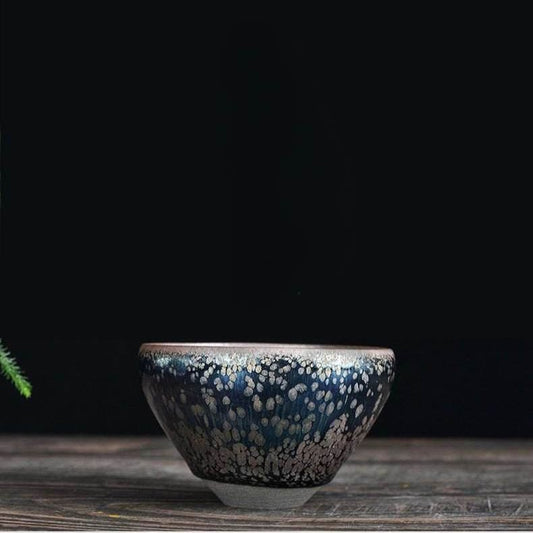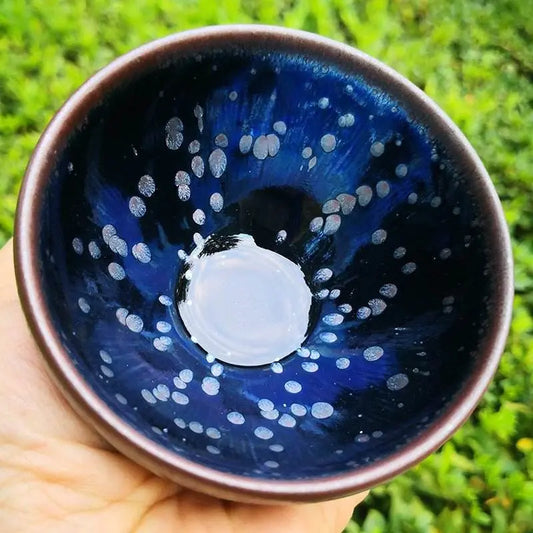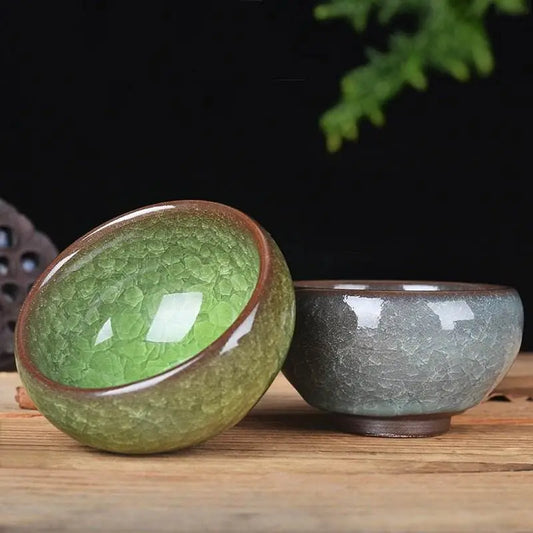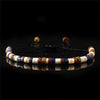-
Eight Chun Map Jianzhan Tea Cup – Stylish and Charming, Great for Tea Lovers
Regular price $25.88save: 50% Sale price $25.88 Regular priceUnit price / per$51.99✨ Gold - covered Jianzhan Tea Cups with Eight Chun Map - Meditation Cup, Dragon King Cup, Nine - peach Cup, Master Cup, Personal Kungfu Tea Cup
Experience the charm of jianzhan tea cups with our Gold - covered Jianzhan Tea Cups featuring the Eight Chun Map. These cups are exquisitely designed, with a diameter of 8.3cm, a height of 6cm, and a capacity of 190ml. The cups are decorated with vivid patterns, such as galloping horses and oxen, combining traditional art with modern craftsmanship. They are not only practical for making kungfu tea but also serve as elegant decorative items, suitable for various tea - tasting occasions.
💎 Why Choose These Jianzhan Tea Cups
- ✨ Exquisite Patterns: Vivid Eight Chun Map and other patterns, rich in cultural connotations.
- ⚡ High - quality Craftsmanship: Meticulously made, with a perfect combination of gold - covered surface and fine painting.
- 🍃 Versatile Use: Ideal for personal use, tea ceremonies, and as a gift for tea lovers.
✨ Key Features
- 🎨 Gold - covered Surface: Adds an elegant and luxurious touch.
- 🎨 Vivid Patterns: Intricate paintings of horses, oxen, etc., showing traditional art.
- 🎯 Ideal Size: Diameter 8.3cm, height 6cm, capacity 190ml, suitable for kungfu tea.
📌 Perfect For
- 🏠 Personal Tea - tasting: Enjoying a peaceful tea - time at home.
- 🍵 Tea Ceremonies: Adding an artistic touch to formal tea - tasting events.
- 🎁 Gift: Ideal for those who appreciate traditional tea culture and art.
Sale -
Jianzhan Tea Cup – Handmade Persimmon Red Auspicious Clouds, Luxurious & Exquisite
Regular price $25.88save: 51% Sale price $25.88 Regular priceUnit price / per$52.99✨ Jianzhan Tea Cup: Handmade Persimmon - Red Auspicious Cloud Jianzhan — Ceramic Iron - Bodied Kiln - Transformed Tea Bowl, Single Master Cup for All
Experience the essence of jianzhan tea cup with our Handmade Persimmon - Red Auspicious Cloud Jianzhan. Crafted with iron - bodied and original ore glaze, free from chemical glazes, this cup is a masterpiece of traditional craftsmanship. With 21 - step meticulous craftsmanship, 72 - hour forming, 1350° high - temperature firing, and 80 - hour fuel burning, it ensures quality and uniqueness. The cup, with a size of 9.0×6.0cm and capacity of about 140ml, making it perfect for both personal use and gifting.
💎 Why Choose This Jianzhan Tea Cup
- ✨ Original Ore Material: Iron - bodied and original ore glaze, safe and authentic.
- ⚡ Handmade Craftsmanship: Pure manual production, ensuring each cup is unique.
- 🍃 Kiln - Transformed Beauty: Persimmon - red auspicious cloud pattern, visually stunning.
- 🎁 Complete Packaging: Comes with certificate and gift box, ideal for gifting.
✨ Key Features
- 🎨 Traditional Process: 21 - step craftsmanship, high - temperature firing for durability.
- 🎨 Safe Material: Iron - bodied and original ore glaze, free from chemicals.
- 🎯 Perfect Size: Diameter about 9.0cm, height 6.0cm, capacity 140ml.
📌 Perfect For
- 🍵 Daily tea - tasting and kung fu tea rituals.
- 🎁 Gift for tea lovers, with elegant packaging.
- 🏺 Collection for those who appreciate traditional ceramic art.
Sale -
Jianzhan Tea Cup – Handmade Buddha Lotus, Exquisite & Elegant Masterpiece
Regular price $45.88save: 50% Sale price $45.88 Regular priceUnit price / per$91.99✨ Jianyang Jianzhan Buddha - Lotus Jianzhan Tea Cup: Handmade Master Cup
Experience the artistry of jianzhan tea cup with our Jianyang Jianzhan Buddha - Lotus Jianzhan Tea Cup. This handmade master cup embodies traditional craftsmanship, featuring options like kiln - transformed purple and green. Each cup showcases unique patterns and a brilliant, flowing luster , crafted by skilled artisans to reflect the inheritance of Jianzhan techniques. Perfect for tea enthusiasts seeking both beauty and tradition.
💎 Why Choose This Jianzhan Tea Cup
- ✨ Handmade: Ensures uniqueness and high - quality craftsmanship.
- ⚡ Kiln - Transformed Beauty: Rich colors like purple and green, each cup is distinct.
- 🍃 Traditional Heritage: Carries forward ancient Jianzhan making techniques.
✨ Key Features
- 🎨 Traditional Hand - Making: Preserves ancient Jianzhan craftsmanship.
- 🎨 Vivid Kiln - Transformed Colors: Offers kiln - transformed purple and green options.
- 🎨 Unique Buddha - Lotus Pattern: Adds an elegant and spiritual touch.
- 🎨 Flowing Luster: Creates a visually stunning effect.
📌 Perfect For
- 🍵 Daily tea - tasting and kung fu tea sessions.
- 🎁 Gift for tea connoisseurs and collectors.
- 🏺 Collection and display for art and tea enthusiasts.
Sale -
Jianzhan Tea Cup – Green Partridge Design, Luxurious & Exquisite Kiln - Changed Masterpiece
Regular price $25.88save: 51% Sale price $25.88 Regular priceUnit price / per$52.99✨ Jianzhan Tea Cup: Green Partridge Jianzhan Master Cup — Premium Personalized Tea Ware, Jianyao Kiln - Transformed Ceramic Tea, Tied - Mouth High - End Tea Cup
Experience the elegance of jianzhan tea cup with our Green Partridge Jianzhan Master Cup. This premium personalized tea ware, a Jianyao kiln - transformed ceramic tea, features a tied - mouth design and high - end craftsmanship. High - temperature fired, with thick and solid, it embodies the beauty of kiln - transformation. (tied - mouth partridge blue) pattern adds a unique touch, with dimensions: 9.5cm (diameter 9.5cm), 5cm (height 5cm), ≈120ml (capacity ≈120ml). Ideal for tea connoisseurs, it combines functionality with artistic beauty.
💎 Why Choose This Jianzhan Tea Cup
- ✨ High - temperature Fired: Ensures durability and classic Jianzhan quality.
- ⚡ Kiln - Transformed Beauty: Unique green partridge pattern, each cup is one - of - a - kind.
- 🍃 Premium & Personalized: Perfect for individual use, showcasing taste and style.
✨ Key Features
- 🎨 Traditional Craftsmanship: Jianyao origin, preserving ancient kiln - transformed techniques.
- 🎨 Distinctive Design: Tied - mouth style with partridge - like patterns, visually captivating.
- 🎯 Functional & Stylish: Suitable for daily tea - tasting and special occasions.
📌 Perfect For
- 🍵 Daily tea - tasting rituals and kung fu tea sessions.
- 🎁 High - end gifting for tea enthusiasts and collectors.
- 🏺 Display and collection for those who appreciate traditional ceramic art.
Sale -
Jianzhan Tea Cup – Handmade Ink Peony, Elegant & Artistic Kiln - Changed Masterpiece
Regular price $35.88save: 50% Sale price $35.88 Regular priceUnit price / per$71.99✨ Jianzhan Tea Cup: Ink - Wash Peony Handmade Blue Lotus Jianyao General Cup Kiln - Transformed Tea — Retro Tea Ware
Experience the charm of jianzhan tea cup with our Ink - Wash Peony Handmade Blue Lotus Jianyao General Cup. This kiln - transformed tea, a retro tea ware, features unique ink - wash peony and blue lotus patterns. Handmade with precision, it embodies the essence of traditional Jianyao craftsmanship, perfect for tea enthusiasts seeking both artistry and functionality.
💎 Why Choose This Jianzhan Tea Cup
- ✨ Handmade Craftsmanship: Ensures each cup is unique and of high quality.
- ⚡ Kiln - Transformed Beauty: Unique ink - wash peony and blue lotus patterns from kiln - transformation.
- 🍃 Retro Design: Adds an elegant, vintage touch to tea - drinking experiences.
✨ Key Features
- 🎨 Unique Patterns: Ink - wash peony and blue lotus, each cup is a work of art.
- 🎯 Jianyao General Cup: Blends traditional design with modern usability.
- 🎁 Ideal for Gifting: Exquisite and unique, perfect for tea - loving friends or family.
📌 Perfect For
- 🍵 Daily tea - tasting and kung fu tea sessions.
- 🎁 Gift for tea connoisseurs and collectors.
- 🏺 Collection and display for those who appreciate retro and traditional art.
Sale -
Jianzhan Tea Cup – Exquisite Kiln - Changed Crystal, Unique & Elegant for Gongfu Tea
Regular price $28.88save: 51% Sale price $28.88 Regular priceUnit price / per$59.99✨ Jianzhan Tea Cup: Kiln - Transformed Crystal Wanhua Ceramic Tea Cup — Japanese - Style Master Cup for Tea Tasting, Kung Fu Tea Set, Large Tea Bowl
Experience the charm of jianzhan tea cup with our Kiln - Transformed Crystal Wanhua Ceramic Tea Cup. This Japanese - style master cup, ideal for tea tasting, is part of a kung fu tea set and comes in various sizes as a large tea bowl. Crafted with hand - made + wanhua crystal kiln - transformation process, each cup showcases unique patterns from the kiln - transformation, embodying traditional craftsmanship and artistic beauty.
💎 Why Choose This Jianzhan Tea Cup
- ✨ Hand - made + Wanhua Crystal Kiln - Transformation: Ensures each cup is unique with stunning patterns.
- ⚡ Ceramic Material: Durable and suitable for both daily use and special occasions.
- 🍃 Japanese - Style Design: Adds an elegant touch to tea - drinking rituals.
✨ Key Features
- 🎨 Unique Kiln - Transformed Patterns: Each cup has distinct wanhua crystal patterns, a result of the kiln - transformation process.
- 🎯 Multiple Sizes and Capacities: Ranging from 30ml to 75ml, catering to different preferences.
- 🎁 Versatile Use: Perfect for personal tea tasting, kung fu tea sets, or as a gift.
📌 Perfect For
- 🍵 Daily tea - tasting and kung fu tea ceremonies.
- 🎁 Gift for tea enthusiasts and collectors.
- 🏺 Display in Japanese - style or traditional tea - drinking settings.
Sale -
Tenmoku Tea Cup – Premium Sky Eye Design, Stylish & Elegant Gift
Regular price $25.88save: 56% Sale price $25.88 Regular priceUnit price / per$59.99✨ Tenmokun Tea Cup: Large - sized Tianyan Jianzhan Tea Cup — Premium Personalized Master Cup for Tea Tasting, Ceramic Gift
Experience the elegance of tenmokun tea cup with our large - sized Tianyan Jianzhan tea cup. This premium personalized master cup, ideal for tea tasting, is a single - cup ceramic gift. The unique Tianyan pattern and large - sized design make it a standout choice for tea enthusiasts, combining traditional craftsmanship with high - end aesthetics.
💎 Why Choose This Tenmokun Tea Cup
- ✨ Unique Tianyan Pattern: Each cup is a work of art with distinctive patterns.
- ⚡ Large - sized Design: Enhances tea - tasting experience with ample capacity.
- 🍃 Premium Ceramic: Perfect for gifting, exuding luxury and quality.
✨ Key Features
- 🎨 Traditional Craftsmanship: High - temperature fired, preserving ancient Jianzhan techniques.
- 🎨 Stunning Aesthetics: Tianyan pattern, visually captivating and unique.
- 🎯 Spacious Capacity: Ideal for personal use, providing a fulfilling tea - tasting journey.
📌 Perfect For
- 🍵 Daily tea - tasting rituals.
- 🎁 High - end gifting for tea lovers.
- 🏺 Collection and display for art enthusiasts.
Sale -
Jianzhan Tea Cup Meteor Shower Design, Luxurious & Exquisite Masterpiece
Regular price $28.88save: 52% Sale price $28.88 Regular priceUnit price / per$60.99โจ Jianzhan Tea Cup: Meteor Shower Pattern Wujin Silver -ๆ Bucket - Hat Jianzhan โ€” Pure Handmade Master - Level Tea็, Premium Tasting Cup, Master Cup
Experience the elegance of j
✨ Jianzhan Tea Cup: Meteor Shower Pattern Wujin Silver -描 Bucket - Hat Jianzhan — Pure Handmade Master - Level Tea盏, Premium Tasting Cup, Master Cup
Experience the elegance of jianzhan tea cup with our Meteor Shower Pattern Wujin Silver -描 Bucket - Hat Jianzhan. This pure handmade master - level tea盏 is a premium tasting cup and master cup, featuring unique meteor shower patterns and Wujin silver -描 design. Perfect for tea connoisseurs, it combines traditional craftsmanship with high - end aesthetics.
💎 Why Choose This Jianzhan Tea Cup
- ✨ Pure Handmade: Ensures unique craftsmanship and high quality.
- ⚡ Unique Design: Meteor shower pattern with Wujin silver -描, each cup is a masterpiece.
- 🍃 Master - Level Craftsmanship: Reflects exquisite skills and attention to detail.
✨ Key Features
- 🎨 Exquisite Aesthetics: Meteor shower pattern and Wujin silver -描, visually stunning.
- 🎯 Functional & Luxurious: Ideal for premium tea - tasting, a blend of form and function.
- 🎁 High - End Gift: Perfect for gifting to tea enthusiasts and collectors.
📌 Perfect For
- 🍵 High - end tea - tasting events and daily premium tea rituals.
- 🎁 Gift for master - level tea connoisseurs and collectors.
- 🏺 Display in upscale tea - drinking settings, adding an artistic flair.
๐’ Why Choose This Jianzhan Tea Cup
- โจ Pure Handmade: Ensures unique craftsmanship and high quality.
- โก Unique Design: Meteor shower pattern with Wujin silver -ๆ, each cup is a masterpiece.
- ๐ Master - Level Craftsmanship: Reflects exquisite skills and attention to detail.
โจ Key Features
- ๐จ Exquisite Aesthetics: Meteor shower pattern and Wujin silver -ๆ, visually stunning.
- ๐ฏ Functional & Luxurious: Ideal for premium tea - tasting, a blend of form and function.
- ๐ High - End Gift: Perfect for gifting to tea enthusiasts and collectors.
๐“ Perfect For
- ๐ต High - end tea - tasting events and daily premium tea rituals.
- ๐ Gift for master - level tea connoisseurs and collectors.
- ๐บ Display in upscale tea - drinking settings, adding an artistic flair.
Sale -
Jianzhan Tea Cup – Handmade Chai - fired Moyu Queyu, Exquisite & Unique Masterpiece
Regular price $25.88save: 56% Sale price $25.88 Regular priceUnit price / per$59.99✨ Jianzhan Tea Cup: Moyu Jianzhan Sparrow - Feather Pattern, Jianyao Shuiji Handmade Wood - Fired General Footless Bowl Tea盏 — Master Cup for Kung Fu Tea
Experience the artistry of jianzhan tea cup with our Moyu Jianzhan. This sparrow - feather patterned, Jianyao Shuiji handmade wood - fired general footless bowl tea盏 is a master cup for kung fu tea. Crafted with care, it embodies traditional craftsmanship and unique design, perfect for tea enthusiasts.
💎 Why Choose This Jianzhan Tea Cup
- ✨ Handmade Wood - Fired: Ensures unique texture and quality from traditional wood - firing process.
- ⚡ Sparrow - Feather Pattern: Distinctive and beautiful, each cup is a work of art.
- 🍃 Footless Bowl Design: Offers a unique aesthetic and comfortable grip for tea - tasting.
✨ Key Features
- 🎨 Traditional Craftsmanship: Handmade in Jianyao Shuiji, preserving ancient wood - firing techniques.
- 🎨 Unique Pattern: Sparrow - feather pattern, formed naturally during firing, making each cup one - of - a - kind.
- 🎯 Functional & Elegant: Ideal as a master cup for kung fu tea, combining utility and beauty.
📌 Perfect For
- 🍵 Daily kung fu tea practice and ceremonies.
- 🎁 Gift for tea connoisseurs and collectors.
- 🏺 Collection for those who appreciate traditional Jianzhan art.
Sale -
Temmoku Glaze Jianzhan Tea Cup – Artistic & Unique Kiln - Changed Gongfu Set
Regular price $35.88save: 50% Sale price $35.88 Regular priceUnit price / per$71.99✨ Kung Fu Tea Set: Jianzhan Tea Cup with Tenmoku Glaze & Kiln - Transformed Partridge - Spot Pattern — Ceramic Tea Ware
Experience the essence of jianzhan tea cup with our Kung Fu Tea Set. This set features Jianzhan cups with Tenmoku glaze and kiln - transformed partridge - spot patterns, crafted from ceramic. Ideal for tea enthusiasts, it combines traditional craftsmanship with elegant design, enhancing every kung fu tea ritual.
💎 Why Choose This Jianzhan Tea Set
- ✨ Unique Tenmoku Glaze: Beautiful and distinctive, each cup is a work of art.
- ⚡ Kiln - Transformed Partridge - Spot: Natural and unique patterns from kiln - firing.
- 🍃 Ceramic Craftsmanship: Durable and suitable for daily use or special occasions.
✨ Key Features
- 🎨 Traditional Design: Embraces the beauty of Jianzhan with tenmoku glaze and partridge - spot patterns.
- 🎯 Functional Set: Perfect for kung fu tea, providing an authentic experience.
- 🎁 Great for Gifting: Elegant and unique, ideal for tea - loving friends or family.
📌 Perfect For
- 🍵 Daily kung fu tea practice and ceremonies.
- 🎁 Gift for tea connoisseurs and collectors.
- 🏺 Display and use in traditional or modern tea - drinking settings.
Sale -
Jianzhan Tea Cup – Luxurious Purple Gold Oil Drop, Elegant & Exquisite Masterpiece
Regular price $25.88save: 51% Sale price $25.88 Regular priceUnit price / per$52.99✨ Premium Zijin Oil - Drop Hundred - Flower Jianzhan Tea Cup — Personalized Master Cup, Jianyang Jianzhan Ceramic Tea Bowl
Experience the luxury of jianzhan tea cup with our Premium Zijin Oil - Drop Hundred - Flower Jianzhan Tea Cup. Handcrafted in Jianyang, this personalized master cup features unique zijin oil - drop patterns and a hundred - flower design, embodying traditional ceramic art. Perfect for tea connoisseurs, it adds an elegant touch to any tea - drinking ritual.
💎 Why Choose This Jianzhan Tea Cup
- ✨ Premium Quality: Exquisite craftsmanship and high - quality ceramic material.
- ⚡ Unique Design: Zijin oil - drop and hundred - flower patterns, each cup is a masterpiece.
- 🍃 Personalized Master Cup: Ideal for individual use, enhancing the tea - tasting experience.
✨ Key Features
- 🎨 Traditional Craftsmanship: Made in Jianyang, preserving ancient Jianzhan techniques.
- 🎨 Stunning Aesthetics: Zijin oil - drop and hundred - flower glaze, visually captivating.
- 🎯 Functional & Stylish: Suitable for daily use and special occasions, a blend of form and function.
📌 Perfect For
- 🍵 Daily tea - tasting and kung fu tea sessions.
- 🎁 Gift for tea enthusiasts and collectors.
- 🏺 Display in中式 (Chinese - style) settings, adding an artistic flair.
Sale -
Jianzhan Tea Cup – Handmade Green Partridge, Unique & Exquisite Masterpiece
Regular price $28.88save: 52% Sale price $28.88 Regular priceUnit price / per$60.99✨ Handmade Green Partridge Footless Bowl Jianzhan Tea Cup — Personalized Master Cup, Tianmu Tea Bowl
Experience the artistry of jianzhan tea cup with our Handmade Green Partridge Footless Bowl Jianzhan Tea Cup. This personalized master cup, a Tianmu tea bowl, showcases exquisite craftsmanship. The unique green partridge pattern and footless bowl design make it a special choice for tea enthusiasts.
💎 Why Choose This Jianzhan Tea Cup
- ✨ Handmade craftsmanship ensures quality and uniqueness.
- ⚡ Unique green partridge pattern, each cup is a work of art.
- 🍃 Footless bowl design offers a distinct aesthetic and experience.
✨ Key Features
- 🎨 Handmade: Each cup is meticulously crafted, reflecting traditional techniques.
- 🎨 Unique Glaze: The green partridge pattern is formed through high - temperature firing, creating a stunning visual effect.
- 🎯 Functional: Ideal for personal use as a master cup, enhancing tea - tasting experiences.
📌 Perfect For
- 🍵 Daily tea - tasting and kung fu tea rituals.
- 🎁 Gift for tea lovers and collectors.
- 🏺 Collection for those who appreciate Jianzhan art.
⚙️ Technical Specifications
- 🌱 Capacity: 150ml
- 📏 Size: Length 9.5cm, Height 6.6cm
- 🔥 Process: High - temperature firing, ensuring durability and beauty.
⚠️ Care Essentials
- 💦 Clean gently with a soft cloth to avoid scratching the glaze.
- 🗃️ Store in a dry place to maintain its quality.
Sale -
Jianzhan Tea Cup – Blue Lotus Handmade, Elegant & Exquisite for Kung Fu Tea
Regular price $25.88save: 51% Sale price $25.88 Regular priceUnit price / per$52.99✨ Jianyang Jianzhan Blue Lotus Tied - Mouth Cup — Handmade Water Lotus Master Cup for Kung Fu Tea, Jianyao Tea Bowl, Tea Tasting Cup
Experience the elegance of jianzhan tea cup with our Jianyang Jianzhan Blue Lotus Tied - Mouth Cup. This handmade water lotus master cup, a Jianyao tea bowl, is perfect for kung fu tea and tea tasting. The unique blue lotus pattern and tied - mouth design embody traditional craftsmanship, making each cup a special piece for tea enthusiasts.
💎 Why Choose This Jianzhan Tea Cup
- ✨ Handmade in Jianyang, preserving traditional craftsmanship.
- ⚡ Unique blue lotus pattern, each cup is a work of art.
- 🍃 Ideal for kung fu tea and tea tasting, enhancing the experience.
✨ Key Features
- 🎨 Traditional Design: Tied - mouth cup with blue lotus pattern, classic Jianzhan style.
- 🎯 High - Quality: Made as a Jianyao tea bowl, ensuring durability and beauty.
- 🎁 Perfect for Gifting: Special for tea lovers and collectors.
📌 Perfect For
- 🍵 Daily kung fu tea and tea tasting sessions.
- 🎁 Gift for tea enthusiasts and those who appreciate traditional art.
- 🏺 Collection for Jianzhan admirers.
Sale -
Jianzhan Tea Cup – Handmade Blue Kylin, Unique & Exquisite Kiln - Changed Glaze Oil Drop
Regular price $45.88save: 50% Sale price $45.88 Regular priceUnit price / per$91.99✨ Jianzhan Tea Cup: Handmade Blue Kylin Jianyang Jianzhan with Kiln - Transformed Glaze Oil Drop — Master Cup for Kung Fu Tea
Experience the artistry of jianzhan tea cup, a handmade Blue Kylin Jianyang Jianzhan featuring kiln - transformed glaze oil drop. Perfect for kung fu tea, this master cup embodies the essence of traditional craftsmanship. Each cup is unique due to the kiln - transformation process, making it a special addition to any tea collection.
💎 Why Choose This Jianzhan Tea Cup
- ✨ Handmade in Jianyang, ensuring traditional craftsmanship and quality.
- ⚡ Unique kiln - transformed glaze oil drop pattern, each cup is one - of - a - kind.
- 🍃 Ideal for kung fu tea, enhancing the tea - drinking experience.
✨ Key Features
- 🎨 Traditional Craftsmanship: Handmade, preserving ancient techniques.
- 🎨 Unique Aesthetics: Blue Kylin design with kiln - transformed glaze oil drop.
- 🎯 Functional: Perfect as a master cup for kung fu tea.
📌 Perfect For
- 🍵 Daily kung fu tea rituals.
- 🎁 Gift for tea enthusiasts.
- 🏺 Collection for those who appreciate ceramic art.
⚙️ Technical Specifications
- 🌱 Material: High - quality ceramic.
- 🔥 Process: Kiln - transformed glaze oil drop technique.
⚠️ Care Essentials
- 💦 Clean gently with a soft cloth.
- 🗃️ Store in a dry place.
Sale -
Jianzhan Tea Cup – Luxurious Gold - Plated & Colorful Diamond, Elegant & Exquisite for Kung Fu Tea
Regular price $35.88save: 50% Sale price $35.88 Regular priceUnit price / per$71.99✨ Jianzhan Tea Cup: Premium Personalized Master Cup for Kung Fu Tea — Intricate Lotus Design, Gilded & Colorful Diamond - Adorned, Intangible Cultural Heritage Tea Bowl
Experience the elegance of jianzhan tea cup, a premium personalized master cup for kung fu tea. Featuring intricate lotus designs, gilded accents, and colorful diamond adornments, this intangible cultural heritage tea bowl blends artistry and tradition. Perfect for tea connoisseurs, each cup showcases unique craftsmanship for personal use or gifting.
💎 Why Choose This Jianzhan Tea Cup
- ✨ Intangible Cultural Heritage Craftsmanship: Preserves ancient techniques for an authentic tea - drinking experience.
- ⚡ Exquisite Design: Lotus patterns with gilded and colorful diamond adornments add luxury.
- 🍃 Premium Quality: Durable, suitable for daily use and special occasions.
✨ Key Features
- 🎨 Unique Styles: Options like Round - Full Cup (宽8.0cm 高5.5cm, 容量120ml) and Tied - Mouth Cup (宽8.5cm 高5.0cm, 容量110ml), each with distinct aesthetics.
- 🧪 High - Quality Material: Enhances tea flavor and ensures longevity.
- 🎁 Gift - Ready: Comes with an elegant box, ideal for gifting.
📌 Perfect For
- 🍵 Daily Kung Fu Tea: Elevate your tea ritual with a personalized cup.
- 🎁 Festive Gifting: A premium choice for tea - loving friends or family.
- 🏺 Collection: Valuable for its cultural heritage and artistic design.
⚙️ Technical Specifications
- 🌱 Material: High - quality ceramic with gilded and colorful diamond - adorned details.
- 🔥 Process: Traditional Jianzhan craftsmanship combined with modern adornments.
- 📏 Sizes: Round - Full Cup (Width 8.0cm, Height 5.5cm, Capacity 120ml); Tied - Mouth Cup (Width 8.5cm, Height 5.0cm, Capacity 110ml).
- 🎁 Packaging: Elegant box for safe delivery and gifting.
⚠️ Care Essentials
- 💦 Clean gently with a soft cloth—avoid abrasive materials.
- 🗃️ Store in a dry place to maintain luster and quality.
Sale -
Five Elements Jianzhan Tea Cups – Gold-Inlaid Home Gift, Tea Time Stress-Free Joy & Artistic Recognition
Regular price $48.88save: 51% Sale price $48.88 Regular priceUnit price / per$99.99🍵 Jianzhan Tea Cup: Five Elements Creative Ceramic Master Cup, Kiln - Change Gongfu Tea Ware with Gold - Inlaid Jade
Explore the charm of jianzhan tea cup, combining the Five Elements theme with gold - inlaid jade and kiln - change craftsmanship. 🌟 Each cup features unique kiln - change glazes and exquisite gold - inlaid patterns, crafted from high - quality ceramic. Ideal for home use or as a premium gift, it blends tradition, creativity, and functionality seamlessly.
💎 Why Choose This Jianzhan Cup
- ✨ Unique Five Elements theme design, each cup’s kiln - change glaze is uniquely formed
- ⚡ Gold - inlaid jade craft, integrating traditional techniques with modern aesthetics
- 🍃 High - temperature fired ceramic, durable, heat - resistant, and easy to clean
✨ Key Advantages
- 🎨 Innovative Five Elements theme, combining kiln - change art with gold - inlaid jade
- 🧪 Safe ceramic material, lead - free, suitable for daily tea tasting
- 🎁 Elegant design perfect for gifting—ideal as a souvenir or for special occasions
📌 Perfect For These Scenarios
- 🕒 Daily home tea sessions, enjoying the beauty of kiln - change glazes
- 🎁 Festivals, birthdays—exquisite gift for tea lovers and art enthusiasts
- 🏺 Gongfu tea ceremonies, showcasing unique Five Elements - themed tea ware
⚙️ Technical Specifications
- Material: Ceramic
- Process: Kiln - change firing + gold - inlaid craft
- Size: Diameter 8cm × Height 5cm
- Capacity: 130ML
Sale -
Jianzhan Tea Cups – Silver-Inlaid Kiln Masterpiece, Gifting Calm & Collector’s Pride
Regular price $25.88save: 51% Sale price $25.88 Regular priceUnit price / per$52.99🍵 Jianzhan Tea Cup: Kiln - Change Silver - Inlaid Master Cup, Ceramic Petal - Shaped Tea Tasting Cup
Discover the allure of jianzhan tea cup, featuring kiln - change craftsmanship and silver - inlaid petal designs. 🌟 Each cup showcases vibrant, ever - changing kiln - change glazes with elegant silver inlays at the center. Crafted from original ore porcelain clay via traditional techniques, it’s a perfect blend of art and functionality for tea rituals.
💎 Why Choose This Jianzhan Cup
- ✨ Unique petal - shaped design with kiln - change glazes, each cup’s color and pattern is uniquely formed
- ⚡ Silver inlay at the cup’s center adds an elegant touch, combining tradition with sophistication
- 🍃 Made from Dehua original ore porcelain clay, ensuring safety and durability for long - term use
✨ Key Advantages
- 🎨 Traditional craftsmanship preserves the essence of kiln - change art, rich in cultural heritage
- 🧪 High - quality original ore material, lead - free and suitable for daily tea tasting
- 🎁 Ideal for various occasions: home use, tea ceremonies, or as an elegant gift
📌 Perfect For These Scenarios
- 🕒 Daily home tea sessions, enjoying the beauty of kiln - change glazes
- 🎎 Gongfu tea ceremonies, showcasing unique petal - shaped tea ware
- 🎁 Festivals, birthdays—ideal gift for tea lovers and art enthusiasts
⚙️ Technical Specifications
- Material: Original ore porcelain clay
- Process: Traditional craftsmanship
- Size: Diameter 9.0cm × Height 5.0cm
- Capacity: Approximately 100ml
- Origin: Dehua, the Porcelain Capital
Sale -
Zodiac Jianzhan Tea Cups – Kiln-Transformed Craft, Daily Tea Rituals Stress Relief & Connoisseur Prestige
Regular price $25.88save: 51% Sale price $25.88 Regular priceUnit price / per$52.99🍵 Jianzhan Tea Cup: Zodiac-themed Gongfu Tea Cup, Kiln-change Ceramic Master Cup for Men
Discover the charm of jianzhan tea cup, featuring zodiac designs and kiln-change craftsmanship. 🌟 Each cup showcases unique blue kiln-change textures with golden zodiac patterns, combining traditional Jianzhan artistry with modern aesthetics. Ideal for men’s personal tea enjoyment, each cup is a blend of functionality and collectibility.
💎 Why Choose This Jianzhan Cup
- ✨ Unique kiln-change glaze forms stunning blue textures, each cup’s pattern is one-of-a-kind
- ⚡ Golden zodiac laser-engraved patterns, supporting personalized customization for enterprises/individuals
- 🍃 Traditional Jianzhan iron-based clay ensures heat retention, enhancing tea flavor
✨ Key Advantages
- 🎨 Handmade kiln-change craft preserves ancient Jianzhan techniques, rich in cultural heritage
- 🧪 Safe ceramic material, lead-free and durable for long-term use
- 🎁 Zodiac theme + customization service, perfect for gifting or personal collection
📌 Perfect For These Scenarios
- 🕒 Personal daily tea tasting, enjoying exclusive tea-drinking moments
- 🎁 Birthdays, festivals—ideal gift for male tea lovers, colleagues, or friends
- 🏺 Tea ceremonies or business gifting, showcasing taste and cultural connotations
⚙️ Customization Process
- Contact customer service to confirm the product
- Place an order and pay customization fees
- Provide LOGO or design for customization layout
- Production and delivery within 5 days
Sale -
Plum Blossom jianzhan tea cup – High-End Silver Cups, Wedding Gift Anxiety Relief & Artistic Legacy
Regular price $23.88save: 53% Sale price $23.88 Regular priceUnit price / per$50.99🍵 Jianzhan Tea Cup: Plum Blossom Silver - Inlaid Kintsugi Pair Set, Gongfu Tea Ware for Gifting
Experience the charm of jianzhan tea cup, featuring a pair of cups with plum blossom silver - inlay and kintsugi craft. 🌟 The cups show yohen starry - sky hare’s - fur patterns with silver - inlaid plum designs. Packaged in an elegant gift box, ideal for gifting on various occasions while enjoying gongfu tea.
💎 Why Choose This Jianzhan Set
- ✨ Exquisite silver - inlay kintsugi craft, vivid plum patterns with changing yohen glaze
- ⚡ Jianzhan’s iron - based clay retains heat, enhancing tea flavor for a better tasting experience
- 🍃 Premium gift - box packaging, suitable for multiple gifting scenarios
✨ Key Advantages
Unlike ordinary tea sets, this jianzhan tea cup set offers:
- 🎨 Combination of traditional Jianzhan craft and modern silver - inlay kintsugi
- 🧪 Safe ceramic material, durable silver inlay for long - term use
- 🎁 Perfect for birthdays, festivals, teacher’s gifts, weddings—conveying Chinese tea culture
📌 Perfect For These Scenarios
- 🎁 Birthdays, Father’s Day, Teacher’s Day—ideal gifts for loved ones
- 🏺 Gifts for international friends, wedding presents to share tea culture
- 🕒 Daily gongfu tea sessions, perfect for two - person tea - sharing moments
⚙️ Technical Specifications
- 🌱 Material: Ceramic + silver - inlaid kintsugi decor
- 🔥 Process: Yohen firing + handmade silver - inlay kintsugi
- 📏 Size: Single cup diameter 7.5cm × height 4cm
- 🫖 Capacity: About 60ml per cup
- 🎁 Packaging: Luxury gift box (pair set)
⚠️ Care Essentials
- 💦 Wipe with soft cloth and rinse gently with warm water before first use
- 🧼 Avoid hard objects—use soft cloth to clean glaze and silver - inlaid parts
- 🗃️ Store in the gift box to prevent collision and protect decorations
Sale -
Handmade Jianzhan tea cup – Silver Kintsugi Cups, Gifting Relax & Cultural Mastery
Regular price $23.88save: 53% Sale price $23.88 Regular priceUnit price / per$50.99🍵 Jianzhan Tea Cup: Handmade Silver - Inlaid Colorful Tea Cup Set, Gift Box for Master Cups
Explore the charm of jianzhan tea cup, combining handmade silver - inlay craft with colorful yohen glaze in a premium gift box. 🌟 The cups showcase dreamy colorful kiln - change effects with silver - inlaid plum patterns, elegant and古韵. Perfect for personal use or gifting, highlighting craftsmanship and taste.
💎 Why Choose This Jianzhan Set
- ✨ Handmade silver - inlay craft, delicate plum patterns with colorful yohen glaze
- ⚡ Jianzhan’s iron - based clay retains heat, enhancing tea aroma
- 🍃 Gift - box design with two cups, ideal for various gifting occasions
✨ Key Advantages
Unlike ordinary tea sets, this jianzhan tea cup set offers:
- 🎨 Blend of traditional silver - inlay and modern kiln - change craft, high artistic value
- 🧪 Safe ceramic material, durable silver - inlay for long - term use
- 🎁 Elegant gift box with two cups, balancing cost - performance and style
📌 Perfect For These Scenarios
- 🕒 Couples or friends sharing tea, enjoying colorful yohen beauty
- 🎁 Festivals, anniversaries—premium tea gift for loved ones
- 🏺 Tea gatherings, showcasing fusion of traditional craft and modern aesthetics
⚙️ Technical Specifications
- 🌱 Material: Ceramic + silver inlay
- 🔥 Process: Colorful yohen firing + handmade silver - inlay
- 📏 Size: Single cup diameter 6cm × height 5cm
- 🫖 Capacity: About 80ml per cup
- 🎁 Packaging: Luxury gift box (two - cup set)
⚠️ Care Essentials
- 💦 Gently wipe with soft cloth and rinse with warm water before first use
- 🧼 Clean with soft cloth—avoid scratching the silver inlay
- 🗃️ Store in the gift box to prevent collision and protect decorations
Sale -
Zodiac Jianzhan Tea Set – Kiln-Transformed Silver Craft, Tea Ceremony Anxiety Relief & Artistic Legacy
Regular price $28.88save: 45% Sale price $28.88 Regular priceUnit price / per$52.99🍵 Jianzhan Tea Cup: Zodiac Nail - Inlaid Silver Tea Cup Set, Kiln - Change Master Cup Gift Box
Discover the charm of jianzhan tea cup—a zodiac - themed set featuring nail - inlaid silver and kiln - change craftsmanship. 🌟 Each cup in the set showcases unique kiln - change glazes with zodiac patterns, combined with silver inlay for an elegant touch. Housed in a premium gift box, it’s perfect for tea ceremonies and gifting, blending tradition with artistry.
💎 Why Choose This Jianzhan Set
- ✨ Handcrafted zodiac silver inlay and kiln - change glaze, each cup is a unique artwork
- ⚡ Jianzhan’s iron - based clay retains heat, enhancing tea flavor naturally
- 🍃 Exquisite gift - box packaging, ideal for both collection and gifting
✨ Key Advantages
Unlike ordinary sets, this jianzhan tea cup set offers:
- 🎨 Unique zodiac design with silver inlay, combining culture and art
- 🧪 Safe ceramic material, lead - free and durable for long - term use
- 🎁 Gift - ready packaging, suitable for festivals, ceremonies, or personal collection
📌 Perfect For These Scenarios
- 🕒 Daily tea gatherings, enjoying the beauty of zodiac - themed cups
- 🎎 Traditional tea ceremonies, showcasing cultural heritage
- 🎁 Birthdays, festivals, or as a premium gift for tea enthusiasts
⚙️ Technical Specifications
- 🌱 Material: Ceramic + silver inlay
- 🔥 Process: Kiln - change firing + zodiac silver - inlay craft
- 📏 Size: Cup diameter 9.3cm × height 4cm (approx.)
- 🫖 Capacity: About 100ml per cup
- 🎁 Packaging: Luxury gift box for the set
⚠️ Care Essentials
- 💦 Gently rinse cups with warm water before first use
- 🧼 Clean with a soft cloth—avoid abrasive materials on the silver inlay
- 🗃️ Store in the gift box to prevent collision and maintain appearance
Sale -
Jianzhan Tea Cups – Kiln-Transformed Bundle Mouth Design, Tea Ceremony Stress Relief & Connoisseur Prestige
Regular price $28.88save: 45% Sale price $28.88 Regular priceUnit price / per$52.99🍵 Jianzhan Tea Cup: Kiln - Change Ceramic Master Cup for Gongfu Tea
Explore the charm of jianzhan tea cup, featuring kiln - change craftsmanship and rabbit - hair patterns. 🌟 This bundle - mouth “Nine - Five Supreme Cup” showcases stunning blue - silver rabbit - hair textures formed during high - temperature firing. With a capacity of 130ml, it’s perfect for gongfu tea, combining tradition and artistry.
💎 Why Choose This Jianzhan Tea Cup
- ✨ Unique kiln - change rabbit - hair glaze, each cup’s pattern is one - of - a - kind
- ⚡ Traditional Jianzhan iron -胎 craft, enhancing tea flavor with natural water - softening effect
- 🍃 Bundle - mouth design, ergonomic and elegant for both use and display
✨ Key Advantages
Unlike ordinary cups, this jianzhan tea cup offers:
- 🎨 Handmade kiln - change craft, preserving ancient Jianzhan techniques
- 🧪 Safe ceramic material, lead - free and durable for long - term use
- 🎁 Suitable for both daily tea tasting and ceremonial gifting
📌 Perfect For These Scenarios
- 🕒 Daily gongfu tea sessions, enjoying the beauty of rabbit - hair glaze
- 🎎 Tea ceremonies, showcasing traditional Jianzhan culture
- 🎁 Festivals or special occasions as a premium gift for tea enthusiasts
⚙️ Technical Specifications
- 🌱 Material: Ceramic (iron - based clay)
- 🔥 Process: Kiln - change firing with rabbit - hair glaze technique
- 📏 Size: Diameter 9.3cm × Height 5.2cm
- 🫖 Capacity: Approximately 130ml
⚠️ Care Essentials
- 💦 Rinse with warm water before first use
- 🧼 Clean with a soft cloth—avoid abrasive materials on the glaze
- 🗃️ Store in a dry place to maintain glaze luster
Sale -
Jianzhan Tea Cups – Raw Ore Glaze Iron Body, Tea Ceremony Stress Relief & Connoisseur Prestige
Regular price $28.88save: 45% Sale price $28.88 Regular priceUnit price / per$52.99🍵 Jianzhan Tea Cup: Original Ore Glaze Iron Body Colorful Red Beauty Master Cup
Experience the charm of jianzhan tea cup, featuring original ore glaze, iron body, and colorful red beauty patterns. 🌟 The unique ore glaze forms stunning crackle textures, while the iron body helps soften water quality, enhancing tea flavor. Ideal for tea connoisseurs seeking tradition and functionality.
💎 Why Choose This Jianzhan Tea Cup
- ✨ Original ore glaze craft, each cup’s crackle pattern is uniquely formed
- ⚡ Iron body design naturally softens water, improving tea taste
- 🍃 Colorful red beauty texture, combining art and practical use
✨ Key Advantages
Unlike ordinary cups, this jianzhan tea cup offers:
- 🎨 Traditional Jianzhan craftsmanship, preserving ancient techniques
- 🧪 Safe original ore material, lead - free and durable
- 🎁 Elegant appearance, suitable for both daily use and gifting
📌 Perfect For These Scenarios
- 🕒 Daily tea tasting, enjoying softened water and rich tea aroma
- 🎎 Tea ceremonies, showcasing traditional Jianzhan culture
- 🎁 Festivals or special occasions as a premium gift for tea lovers
⚙️ Technical Specifications
- 🌱 Material: Original ore glaze + iron - based clay
- 🔥 Process: Traditional Jianzhan firing technique
- 📏 Size: Diameter [e.g., 8.5cm] (common Jianzhan size)
⚠️ Care Essentials
- 💦 Rinse with warm water before first use
- 🧼 Clean with a soft cloth—avoid abrasive materials on the glaze
- 🗃️ Store in a dry place to maintain glaze luster
Sale -
Jianzhan Tea Cups – Gold-Hare’s Fur Glaze & Zodiac Silver Inlay, Tea Ceremony Stress Relief & Connoisseur Prestige
Regular price $35.88save: 50% Sale price $35.88 Regular priceUnit price / per$72.99🍵 Jianzhan Tea Cup: Jianyang Jianzhan Colorful Buddha Lotus Master Cup
Discover the charm of jianzhan tea cup—handcrafted with colorful glaze and golden lotus patterns. 🌟 The cup features vibrant colors that shine under light, combining traditional Jianzhan craftsmanship with exquisite lotus designs. Each cup is a masterpiece, perfect for tea lovers seeking artistry and culture.
💎 Why Choose This Jianzhan Tea Cup
- ✨ Handmade by skilled artisans, inheriting Jianzhan techniques for unique quality
- ⚡ Colorful glaze with golden lotus patterns, creating a stunning visual effect
- 🍃 Comes with an elegant gift box, ideal for both use and gifting
✨ Key Advantages
Unlike ordinary cups, this jianzhan tea cup offers:
- 🎨 Unique colorful lotus design, blending art and tea culture
- 🧪 High - quality ceramic material, safe and durable for long - term use
- 🎁 Gift - box packaging with inspection report, ensuring quality and elegance
📌 Perfect For These Scenarios
- 🕒 Personal tea - tasting moments, enjoying the beauty of tea and cup
- 🎎 Tea ceremonies or gatherings, showcasing traditional aesthetics
- 🎁 Festivals, birthdays, or as a premium gift for tea enthusiasts
⚙️ Technical Specifications
- 🌱 Material: Premium ceramic + golden glaze
- 🔥 Process: Traditional Jianzhan firing + hand - painted lotus craft
- 📏 Size: [If known, e.g., diameter 8cm] (customizable in different styles)
- 🎁 Packaging: Luxury gift box with inspection certificate
⚠️ Care Essentials
- 💦 Gently rinse with warm water before first use
- 🧼 Clean with a soft cloth—avoid abrasive materials on the glaze
- 🗃️ Store in the gift box to prevent collision and maintain beauty
Sale -
Jianzhan Tea Cups – Song Dynasty Craftsmanship, Tea Ceremony Stress Relief & Collector's Artistic Legacy
Regular price $28.88save: 51% Sale price $28.88 Regular priceUnit price / per$59.99🍵 Jianzhan Tea Cups: Song Dynasty Craft Emerald Porcelain with Inlaid Gold/Silver
Experience the charm of Jianzhan, inheriting Song Dynasty craftsmanship to create emerald green porcelain cups with inlaid gold/silver. 🌟 The emerald porcelain is warm and crystal - clear, with hand - inlaid gold/silver decorations like dragon patterns, elegant and noble. It’s a perfect blend of practical use, tea art, and collection value.
💎 Why Love Jianzhan Tea Cups
- ✨ Emerald green porcelain combined with hand - inlaid gold/silver craft, elegant and noble
- ⚡ Inheriting Song Dynasty craftsmanship, with transparent and smooth glaze for enhanced tea - tasting experience
- 🍃 Unique design integrating practical, ornamental, and collection values
✨ Key Advantages
Unlike ordinary tea sets, Jianzhan Tea Cups offer triple benefits:
- 🎨 Hand - inlaid gold/silver decorations, each cup with unique patterns, full of artistry
- 🧪 High - quality porcelain material, lead - free and safe for long - term use
- 🎁 Exquisite gift packaging, suitable for tea ceremonies, daily use, or gifting
📌 Perfect For These Scenarios
- 🕒 Daily tea - drinking to relieve stress and enjoy peaceful moments
- 🎎 Traditional tea ceremonies and high - end tea gatherings to show cultural heritage
- 🏺 As art collections or premium gifts for festivals and anniversaries
⚙️ Technical Specifications
- 🌱 Material: Emerald porcelain + hand - inlaid gold/silver
- 🔥 Process: Song Dynasty porcelain craft + hand - inlay
- 📏 Size: 9cm (D) × 5cm (H)
- 🫖 Capacity: Approx 120ml
⚠️ Care Essentials
- 💦 Wipe with a soft cloth and gently rinse with warm water before first use
- 🧼 Avoid hard objects when cleaning—use a soft cloth with warm water for glaze and gold/silver parts
- 🗃️ Store without collision—use a separate gift box to prevent gold/silver oxidation
Sale -
Jianzhan Tea Cups Ingot Handcrafted Ceramics, Tea Ceremony Stress Relief Collector's Artistic Legacy
Regular price $28.88save: 51% Sale price $28.88 Regular priceUnit price / per$59.99🍵 Jianzhan Tea Cups: Handmade Jianzhan Ceramics for Tea Ceremony and Art Collection
Discover the unique charm of Jianzhan Tea Cups, which inherits the thousand - year - old Jianzhan craftsmanship and is meticulously hand - crafted. 🌟 Each tea cup is made of a unique iron body. After high - temperature firing, it forms a deep, ink - like Jianzhan glaze, resembling a mysterious galaxy in the night sky. Whether in a tea ceremony or daily tea - drinking, it allows you to feel inner peace and relaxation, making it a must - have art treasure for collectors.
💎 Why Love Jianzhan Tea Cups
- ✨ Handmade, each tea cup is unique, containing the efforts and wisdom of the craftsman.
- ⚡ Iron body material, with good heat - retention performance, better maintaining the temperature and taste of the tea.
- 🍃 Jianzhan glaze shows rich color changes under different light angles, highly ornamental.
✨ Key Advantages
Compared with ordinary tea cups, Jianzhan Tea Cups have three significant advantages:
- 🎨 High artistic value, a perfect combination of traditional craftsmanship and modern aesthetics, suitable for art collection.
- 🧪 Safe material, strictly tested without harmful substances, can be used with confidence.
- 🎁 Exquisite packaging, an ideal high - end gift for friends and relatives, showing taste and friendship.
📌 Perfect For These Scenarios
- 🕒 Daily home tea - drinking, enjoying peaceful personal time and relieving life stress.
- 🎎 Traditional tea ceremonies, adding a sense of ritual and cultural atmosphere, showing the unique charm of tea art.
- 🏠 Home decoration display, as an art ornament, enhancing the artistic style of the space.
⚙️ Technical Specifications
- 🌱 Material: Iron body + Jianzhan glaze
- 🔥 Process: Handmade, high - temperature firing (about 1300℃)
- 📏 Size: [Fill if known, e.g., 9cm (D) × 5cm (H)]
- 🫖 Capacity: [Fill if known, e.g., 120ml]
⚠️ Care Essentials
- 💦 Rinse with warm water before first use to remove surface impurities.
- 🧼 When cleaning daily, gently wipe with a soft cloth to avoid scratching the glaze.
- 🗃️ When storing, avoid collision and extrusion. It is recommended to use a special tea cup storage box.
Sale -
Jianzhan Tea Cups – Handmade Blue Oil-Drop Design, Tea Ceremony Stress Relief & Connoisseur Prestige
Regular price $25.88save: 50% Sale price $25.88 Regular priceUnit price / per$51.99🍵 Jianzhan Tea Cups: Handmade Blue Oil - Drop Craft for Tea Rituals
Explore the charm of Jianzhan Tea Cups—inheriting Song Dynasty Jianyang Shuidi craftsmanship, featuring handmade blue oil - drop design. 🌟 The glaze oil - drops scatter like stars, forming unique “glaze tears” during high - temperature firing. Each cup is a craft masterpiece, turning tea time into stress - relief enjoyment.
💎 Why Tea Enthusiasts Choose Jianzhan Tea Cups
- ✨ Blue oil - drop glaze craft, uniquely formed spots under high heat—each cup is one - of - a - kind
- ⚡ Ancient firing technique, thick body for excellent heat retention, enhancing tea flavor
- 🍃 Blend historical heritage and artistry, showing tea - tasting connoisseurship
✨ Key Advantages
Unlike ordinary cups, Jianzhan Tea Cups offer triple benefits:
- 🎨 Handmade blue oil - drop glaze, combining art and function
- 🧪 Natural mineral clay, lead - free and safe for long - term use
- 🎁 Classic shape fits various occasions—tea ceremonies, daily sipping, or premium gifting
📌 Perfect For These Scenarios
- 🕒 Daily solo tea moments to relieve stress
- 🎎 Traditional tea ceremonies and gatherings to show cultural heritage
- 🏺 Display as art collection to showcase personal taste
⚙️ Technical Specifications
- 🌱 Material: Jianyang natural mineral clay + iron - based glaze
- 🔥 Process: Ancient wood - firing/electric firing, high - temperature reduction
- 📏 Size: [Fill if known, e.g., 9.5cm (D) × 5.5cm (H)]
- 🫖 Capacity: [Fill if known, e.g., 135ml]
⚠️ Care Essentials
- 💦 Clean with soft cloth and rinse with warm water before first use
- 🧼 Avoid hard brushes—use soft cloth for daily cleaning to maintain glaze luster
- 🗃️ Store without collision—recommended to display individually or use a special gift box
Sale -
Jianzhan Tea Cups – Home Ice Crackle Glaze, Stress Relief for Daily Sipping & Connoisseur Pride
Regular price $25.88save: 50% Sale price $25.88 Regular priceUnit price / per$51.99🍵 Jianzhan Tea Cups: Home Ice Crackle Glaze for Daily Stress - Free Sipping
Explore the charm of Jianzhan Tea Cups—featuring classic ice crackle glaze, inheriting Jianzhan craftsmanship. 🌟 The unique glaze texture blooms like ice cracks, letting you release stress with every sip in daily use.
💎 Why Love Jianzhan Tea Cups
- ✨ Ice crackle glaze craft, each cup’s texture is unique, showing natural aesthetics
- ⚡ High - quality body material, good heat retention for better tea taste
- 🍃 Balances daily use and collection value, showing connoisseur taste
✨ Key Advantages
Unlike ordinary cups, Jianzhan Tea Cups offer triple benefits:
- 🎨 Traditional craft meets modern aesthetics, combining visual and practical appeal
- 🧪 Tested lead - free material, safe for daily use
- 🎁 Simple design fits various scenarios, ideal for self - use or gifting
📌 Perfect For These Scenarios
- 🕒 Daily home use for relaxation
- 🎎 Small gatherings with friends to share tea fun
- 🏠 Home display to show artistic taste
⚙️ Technical Specifications
- 🌱 Material: Natural mineral soil + ice crackle glaze
- 🔥 Process: Traditional Jianzhan firing technique
- 📏 Size: [Fill if known, e.g., 9cm (D) × 5cm (H)]
- 🫖 Capacity: [Fill if known, e.g., 130ml]
⚠️ Care Essentials
- 💦 Rinse with warm water before first use to remove impurities
- 🧼 Clean with a soft cloth—avoid scratching the glaze
- 🗃️ Store without stacking to prevent collision damage
Sale
Collection: Tea Cups
Chinese tea cups are not just functional objects, but hold deep cultural and historical significance. From the simple clay cups of ancient times to the intricate porcelain and clay masterpieces of today, these tea cups are symbols of a rich tradition that spans millennia. Their design, symbolism, and craftsmanship tell the story of China's long relationship with tea and the spiritual journey that this beverage represents.
In this article, we’ll explore the fascinating history of Chinese tea cups, the types of cups used in tea ceremonies, and the meanings behind the designs that have been passed down through generations.
The History of Chinese Tea Cups 🏯
Origins of Tea Drinking in China 🍃
Tea is an integral part of Chinese culture, and its history dates back over 5,000 years. According to legend, Emperor Shen Nong discovered tea in 2737 BCE when tea leaves blew into a pot of boiling water he was preparing. While this story may be apocryphal, it symbolizes tea’s deep connection with Chinese history and culture. Initially, tea was used as a medicinal herb, believed to have health benefits, before becoming a beloved beverage.
Over time, tea became more than just a health drink. By the Tang Dynasty (618-907 AD), it had become a popular drink, consumed by people from all walks of life, from peasants to royalty. Tea drinking became a social event, and tea cups began to evolve from simple containers to artistic and symbolic vessels used in elaborate tea ceremonies.
Evolution of Tea Cups 🍵🖋️
The evolution of Chinese tea cups is a reflection of the changing times, culture, and values of the Chinese people. Early tea cups were rudimentary and practical, but over the centuries, they became symbols of artistry and refinement.
-
Tang Dynasty (618-907 AD): Tea cups during this time were often simple, made from clay or porcelain. They were primarily functional and served as basic vessels for brewing and drinking tea. However, the Tang period also marks the early rise of tea drinking as a social activity.
-
Song Dynasty (960-1279 AD): The Song Dynasty saw the rise of porcelain tea cups, known for their refined designs and elegance. Tea drinking became associated with leisure, and porcelain cups began to be decorated with intricate patterns of flowers, birds, and symbolic designs. During this period, tea was elevated to a high art form, and the tea cup became a symbol of intellectual refinement and social status.
-
Ming Dynasty (1368-1644 AD): The Ming Dynasty is credited with introducing Yixing clay tea cups, which are still highly prized today. Known for their natural beauty and ability to enhance the taste of tea, these cups were made from clay that was believed to interact with tea in a way that elevated its flavor profile. The cups from this era were often simple and elegant, emphasizing the beauty of natural materials.
-
Qing Dynasty (1644-1912 AD): The Qing Dynasty further refined tea cup designs, creating intricate and decorative cups made from porcelain. The Qing period saw the development of highly ornate tea cups, often hand-painted with scenes of nature, historical events, and even calligraphy. The designs were elaborate, reflecting the wealth and social status of the owner.
Tea and the Chinese Dynasties 🌿👑
Throughout the various dynasties, tea drinking became an essential part of Chinese culture, influencing social life, art, and politics. Each dynasty introduced new customs, ceremonies, and types of tea cups that would shape tea culture for generations.
-
Ming Dynasty: The Ming Dynasty marks a significant period in tea culture, where tea cups, particularly Yixing clay tea cups, became integral to tea ceremonies. These cups were designed with simplicity and functionality in mind, and they quickly became highly prized by tea connoisseurs. The Yixing clay is known for its unique porous nature, which helps to retain the tea’s natural flavors, making it a favorite for brewing oolong and pu-erh teas.
-
Qing Dynasty: The Qing Dynasty is known for its more luxurious and decorative tea cups, which were used during formal tea ceremonies. These cups were often elaborately decorated with symbols of good fortune, prosperity, and longevity. The Qing period is also known for the development of porcelain tea cups that became globally recognized for their fine craftsmanship and beauty.
The Role of Tea Cups in Chinese Tea Ceremonies 🍃🙏
Tea drinking in China is much more than a casual experience—it’s an intricate ceremony that emphasizes respect, mindfulness, and harmony. Tea cups play a central role in these ceremonies, each serving a specific purpose in the ritual.
-
Gong Fu Cha (功夫茶): One of the most well-known Chinese tea ceremonies is Gong Fu Cha, which involves using small, elegant tea cups to carefully brew and sip tea. The ceremony emphasizes the art of tea preparation and the enjoyment of tea's aroma, flavor, and visual appeal. Tea cups used in this ceremony are typically small and refined, allowing for multiple infusions to extract the full flavor of the tea.
-
Respect and Generosity: In Chinese culture, offering tea to guests is a gesture of respect and generosity. The tea cups used in these ceremonies are often chosen with great care to reflect the occasion and the host's reverence for the guest. Whether the ceremony is grand or simple, the tea cups serve as a symbol of hospitality and cultural etiquette.
Types of Chinese Tea Cups 🍵
Chinese tea cups come in a wide variety of materials, each chosen for its unique properties and symbolism. Let’s take a look at the different types of Chinese tea cups and their significance.
Porcelain Tea Cups 🏺💮
Porcelain has long been the material of choice for Chinese tea cups. The material is known for its delicate texture, smooth finish, and ability to retain heat, making it ideal for brewing and drinking tea. Porcelain cups are often decorated with intricate designs, many of which carry deep cultural significance.
-
Symbolism: Porcelain tea cups are often adorned with designs such as dragons, phoenixes, and lotus flowers, each representing good fortune, spiritual enlightenment, and purity. These symbols have been used for centuries to impart positive energy to the tea-drinking experience.
-
Uses: Porcelain tea cups are versatile and suitable for a variety of teas, including green tea, oolong tea, and black tea. The smooth surface of porcelain enhances the flavor and aroma of the tea, making it a popular choice for both casual and formal tea ceremonies.
Yixing Clay Tea Cups 🏺🖤
Yixing clay is a unique type of clay that originates from the Yixing region in China. Known for its porous nature, Yixing clay absorbs the flavors of the tea over time, which enhances the taste with each use. Yixing tea cups are revered for their natural beauty and their ability to bring out the best in tea.
-
Symbolism: Yixing clay tea cups represent simplicity, harmony, and the natural world. The clay’s earthy tones connect tea drinkers to the earth and symbolize the balance between man and nature.
-
Uses: These tea cups are particularly popular for brewing oolong tea, pu-erh tea, and black tea. The porous nature of Yixing clay allows the tea to breathe and develop a richer flavor profile over time, making it ideal for tea connoisseurs who appreciate the subtleties of tea.
Glass Tea Cups 🍶🌿
Glass tea cups have gained popularity in recent years, especially among tea drinkers who enjoy watching the brewing process. The transparent nature of glass allows the drinker to appreciate the color and clarity of the tea, adding a visual element to the experience.
-
Symbolism: While glass tea cups do not carry the same deep cultural symbolism as porcelain or Yixing clay, they are associated with transparency, clarity, and purity—qualities that are essential for enjoying a fine cup of tea.
-
Uses: Glass tea cups are perfect for teas that have a visual appeal, such as flowering teas, where the tea leaves bloom into a beautiful display. They are also ideal for delicate teas like white tea and green tea, where clarity is important for appreciating the nuances of the tea.
Gaiwan (Lidded Cups) 🍃🍶
A Gaiwan is a traditional Chinese tea cup consisting of three parts: a bowl, a lid, and a saucer. The Gaiwan is used both for brewing and drinking tea, and it plays an essential role in the Gong Fu Cha ceremony.
-
Symbolism: The Gaiwan represents balance and harmony, bringing together the elements of tea, water, and air. Its simple, elegant design reflects the Chinese philosophy of Yin and Yang, where opposing forces are balanced in perfect harmony.
-
Uses: The Gaiwan is used for brewing a variety of teas, including green tea, oolong tea, and white tea. Its lid helps regulate the temperature while steeping, ensuring that the tea maintains its delicate flavors and aromas.
Lacquered or Hand-painted Tea Cups 🎨🍃
Lacquered or hand-painted tea cups are often used as decorative pieces, showcasing Chinese artistry and craftsmanship. These cups are adorned with intricate designs, ranging from nature scenes to calligraphy, and are often passed down through generations.
-
Symbolism: The artistry of lacquered and hand-painted tea cups reflects the importance of beauty and craftsmanship in Chinese culture. These cups often feature symbols of good luck, prosperity, and longevity.
-
Uses: While these cups are often reserved for special occasions or ceremonial purposes, they can also be enjoyed for daily tea drinking, particularly when one wishes to elevate the experience.
Jianzhan Tea Cups 🍂✨
Jianzhan tea cups, made from clay sourced from the Jian region of China, are famous for their distinct glaze patterns, particularly the hare’s fur glaze. These cups were first created during the Song Dynasty and are revered for their rarity and beauty.
-
Symbolism: The unique glaze patterns of Jianzhan tea cups symbolize the natural world and the passage of time. The glaze is created through a specific firing technique, which produces a rich, textured surface that enhances the tea-drinking experience.
-
Uses: Jianzhan cups are ideal for green tea and oolong tea, as the rich glaze and texture complement the flavors of these delicate teas. The craftsmanship and rarity of Jianzhan tea cups make them prized possessions for tea collectors.
Tenmoku Tea Cups 🍂🎋
Tenmoku tea cups, while developed in Japan, have deep roots in Chinese tea culture, particularly influenced by the Jianzhan style. The Tenmoku glaze is known for its dark, rich colors, often with a speckled pattern resembling a starry sky.
-
Symbolism: The Tenmoku glaze symbolizes depth and mystery, with its dark tones reflecting the hidden beauty of nature. It also signifies purity and quiet contemplation.
-
Uses: Tenmoku tea cups are best used for oolong tea, where the complex flavors can be fully appreciated. They are also perfect for showcasing the art of tea brewing and the serene atmosphere of a traditional tea ceremony.
Symbolism of Chinese Tea Cups 🐉💫
Tea cups in Chinese culture are not just vessels for drinking; they are imbued with deep meanings, representing aspects of life, nature, and the universe. Each material, design, and pattern has its own symbolic significance, contributing to the overall tea-drinking experience.
Symbolism of Materials 🏺
Different materials used to create tea cups in China carry significant symbolism that reflects the philosophy and values of Chinese culture. Whether it’s porcelain, Yixing clay, glass, or lacquered wood, the material plays a key role in conveying deeper meanings:
-
Porcelain: Representing purity and elegance, porcelain tea cups are highly revered for their smooth surface and aesthetic beauty. These cups symbolize refinement, serenity, and the spiritual connection between the tea drinker and the natural world.
-
Yixing Clay: Known for its earthy tones and ability to enhance the flavors of tea, Yixing clay represents harmony with nature. The porous nature of Yixing clay allows the cup to "absorb" the tea’s essence, making each brew richer over time, symbolizing growth and connection to the earth.
-
Glass: Although glass does not carry the same deep historical symbolism as porcelain or Yixing clay, it represents clarity and transparency. It’s perfect for appreciating the color and clarity of the tea, reflecting the value of purity and openness in Chinese culture.
Common Designs and Their Meanings 🌸🐉
The designs on Chinese tea cups are not just decorative; they are filled with symbolic meanings that align with Chinese philosophy and spirituality. Here are some of the most common motifs:
-
Dragons and Phoenixes 🐉🦅: These mythical creatures symbolize good fortune, strength, and prosperity. The dragon is associated with masculinity, power, and good luck, while the phoenix represents rebirth, beauty, and grace. These symbols are often featured on porcelain tea cups to bring positive energy to the tea-drinking experience.
-
Lotus Flowers 🌸: The lotus is a powerful symbol of purity and spiritual enlightenment. It grows from the mud yet blooms beautifully above the water’s surface, symbolizing the ability to rise above adversity and remain pure in spirit. Tea cups adorned with lotus designs are a reminder of inner peace and transcendence.
-
Peach Blossoms 🍑: In Chinese culture, the peach represents longevity, immortality, and good health. It’s often depicted in tea cups as a symbol of vitality and a long, prosperous life. This design is commonly found on cups used during significant events like birthdays and celebrations.
-
Bamboo 🎋: Bamboo is a symbol of resilience, strength, and flexibility. Its ability to bend without breaking makes it a powerful metaphor for the ability to adapt to challenges in life. Tea cups featuring bamboo designs are reminders to stay strong and flexible during difficult times.
-
Crane Birds 🦢: Cranes are long associated with longevity and immortality in Chinese culture. These graceful birds are often depicted in tea cups as symbols of enduring strength and wisdom. They are especially popular in tea cups used for spiritual or meditative purposes.
Balance and Harmony in Tea Cups ⚖️🌿
In traditional Chinese philosophy, balance and harmony are essential elements in all aspects of life, from personal relationships to environmental practices. Yin and Yang, the ancient Chinese concept of opposing forces that balance one another, is reflected in the design of tea cups.
-
Yin and Yang: Tea cups are designed to maintain balance between opposing forces, such as light and dark, smooth and rough, or solid and fluid. In this way, the design of a tea cup is often meant to evoke balance between the energy of the tea, the person drinking it, and the surrounding environment.
-
Circular Designs: Circular shapes, like those of most tea cups, are also symbolic of the universe and wholeness. This shape represents an eternal cycle, free from beginning or end, reflecting the continuity of life and the infinite flow of energy.
Modern Significance of Chinese Tea Cups 🌏
While Chinese tea cups have deep traditional roots, their significance has continued to evolve. Today, they are used not only in formal tea ceremonies but also as decorative items, collectibles, and even as a way to connect to the past.
Tea Culture Around the World 🌍
Chinese tea cups have become an iconic part of global tea culture. Their designs and craftsmanship are admired by tea drinkers worldwide, and they have influenced tea-drinking rituals beyond China. In places like Japan, Taiwan, and even Western countries, Chinese tea cups are valued for their beauty, function, and the cultural history they carry.
-
Japanese Influence: The Japanese tea culture has been greatly influenced by Chinese tea practices, especially the Gong Fu Cha tea ceremony. Tenmoku cups, originally inspired by Chinese tea cups, are now a staple in Japanese tea ceremonies, showcasing how Chinese tea cups continue to shape global tea rituals.
-
International Tea Collectors: Chinese tea cups, particularly antique porcelain or Yixing clay cups, are highly sought after by collectors. These cups are not only valued for their artistic beauty but also for the cultural significance they represent.
Tea Cups as Decorative Art 🎨🍃
Over the years, Chinese tea cups have transcended their original purpose and become decorative items in their own right. Many tea enthusiasts collect these cups for their intricate designs and craftsmanship. Whether they feature hand-painted landscapes, calligraphy, or porcelain dragons, each tea cup tells a story that adds to its value.
-
Collector’s Items: Rare tea cups, especially those from the Qing Dynasty or ancient Jianzhan cups, are highly prized by collectors. These cups are often seen as art pieces that preserve Chinese cultural heritage.
-
Home Décor: Tea cups are also used as decorative objects in homes and tea rooms. Displayed on shelves or tables, they add an elegant touch to any space, serving as a reminder of the artistry and cultural history behind each vessel.
Tea Cups in Contemporary Life 🏡💫
In modern times, Chinese tea cups continue to play an important role in the daily lives of many people. While they may no longer be used in traditional tea ceremonies as frequently, their cultural value and aesthetic appeal remain high.
-
Mindfulness and Wellness: Many people use Chinese tea cups as part of their daily tea-drinking rituals to enhance mindfulness and well-being. The simple act of sipping tea from a beautifully crafted cup can promote a sense of calm and presence, aligning with the Chinese philosophy of balance and harmony.
-
Everyday Use: Chinese tea cups have also found their way into everyday tea drinking. Whether enjoyed with green tea, oolong tea, or black tea, these cups are a reminder of the rich history and tradition that comes with each sip.
How to Care for Your Chinese Tea Cups 🧼✨
Taking care of your Chinese tea cups is essential for maintaining their beauty and functionality. Whether you own Yixing clay, porcelain, or glass tea cups, proper care ensures they will last for years and continue to enhance your tea-drinking experience.
Cleaning and Maintenance 🧽
-
Yixing Clay Cups: Yixing tea cups are porous, meaning they absorb the tea’s flavor over time. To clean them, simply rinse with warm water. Avoid soap or detergent, as it may strip away the natural oils that build up from tea brewing. Over time, the tea cup will develop a natural patina that enhances its flavor.
-
Porcelain Cups: Porcelain tea cups should be cleaned with a mild detergent and warm water. Use a soft cloth or sponge to avoid scratching the surface. Porcelain cups should also be kept free of stains by cleaning them immediately after use, especially if they’re used for darker teas like black tea.
-
Glass Cups: Glass tea cups are the easiest to clean, requiring only a mild detergent and warm water. You can also use a little bit of vinegar to remove any tea stains. Dry them carefully with a soft cloth to prevent water spots.
Storing Your Tea Cups 🏺
-
Avoid Extreme Temperatures: Store your tea cups in a cool, dry place. Avoid exposing them to extreme temperatures or direct sunlight, which can cause cracks, fading, or damage to the glaze.
-
Use Protective Storage: For valuable or delicate tea cups, use protective cases or display cabinets to keep them safe from dust and breakage.
Avoiding Common Mistakes ❌
-
Don’t Use Harsh Chemicals: Avoid using harsh chemicals or abrasive sponges to clean your tea cups, as this can damage the surface and remove the natural oils or glazes.
-
Don’t Overstack: If you have multiple tea cups, avoid stacking them too high, as this can cause them to crack or chip. Keep each cup separate, with protective padding if necessary.
Conclusion – Embrace the Timeless Tradition of Chinese Tea Cups 🌟
Chinese tea cups are far more than simple vessels—they are a symbol of history, culture, and artistry. From their humble beginnings to their elevated status in tea ceremonies around the world, these cups continue to inspire admiration and reverence.
Whether you use them in a traditional tea ceremony, collect them as art pieces, or simply enjoy a daily cup of tea, Chinese tea cups are a beautiful reminder of the rich cultural heritage and mindfulness that tea brings to our lives. Embrace the tradition and craftsmanship behind these timeless vessels, and let them enhance your own tea-drinking experience.





